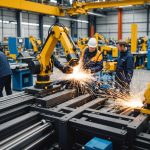Workplace safety is evolving rapidly as cutting-edge technologies redefine how we protect employees. From virtual reality training programs to IoT devices that monitor conditions in real time, these advancements address unique safety challenges across different industries. By leveraging these tools, businesses not only comply with regulations but also foster a culture of safety. Discover how innovative technology can transform safety protocols and enhance overall workplace well-being.
Technology Transforming Workplace Safety
Technology is revolutionizing the landscape of workplace safety by introducing innovative solutions tailored to industry-specific challenges. From advanced monitoring systems in the Internet of Things (IoT) to wearable technologies, the focus is on enhancing safety compliance and achieving improved safety outcomes through technology. For instance, IoT enables real-time monitoring, allowing for the quick detection of hazards such as equipment failures or environmental threats. These advancements in workplace health technology also integrate technology-driven safety compliance, ensuring regulations are met effectively.
In parallel : Essential guide to developing a robust data privacy policy for uk healthcare providers: a step-by-step framework
Wearable technology, like smart safety equipment, continuously monitors vital signs, thereby alerting supervisors if an employee’s health is compromised. Such innovations significantly reduce injury risks and improve employee well-being. Drones, another technological marvel, offer unprecedented insight into potential hazards by inspecting dangerous areas without human intervention. For emergency preparedness, technology provides automated safety protocols that can be activated with precision during crisis situations.
These transformations illustrate how workplace safety policies are being reshaped. As organizations adopt and integrate such technologies, Learn more about it to understand the ongoing shift towards safety culture enhancement through technology-driven solutions.
Have you seen this : Marking buoys in saudi arabia: ensuring safe navigation
Key Technological Innovations in Workplace Safety
Wearable Safety Technology
Wearable safety devices for employees are game-changers in enhancing workplace safety. These devices continuously track and monitor health metrics such as heart rate, body temperature, and stress levels. By incorporating real-time monitoring systems, they offer immediate alerts to both workers and supervisors in case of any anomalies that suggest potential health risks. This proactive alert system allows for quick intervention, potentially preventing accidents before they occur. In industries where employees face physical demands, these smart safety equipment for workplaces not only safeguard health but also boost morale and productivity.
Real-Time Monitoring Systems
The integration of IoT applications in workplace safety enables advanced real-time monitoring. By employing sensors to track environmental factors such as air quality, temperature, and equipment performance, these systems detect potential hazards before they manifest. Such technologies enhance automated safety protocols in workplaces, ensuring quick corrective actions are taken to minimize risks. This approach not only reduces accident rates but also supports compliance with safety regulations, contributing to a robust safety culture within organizations.
Drone and Robotics in Safety Inspections
Drone technology for safety inspections has revolutionized how hazardous environments are assessed. By using drones, workplaces can conduct safety analyses in areas that are risky for human inspectors. These drones gather comprehensive data, enabling teams to perform accurate risk assessments remotely. Smart safety equipment for workplaces, paired with robotics and drones, further ensures that repeated exposure to danger is minimized, promoting a safer working environment and enhancing predictive maintenance efforts across various industries.
Implementing and Adopting Safety Technologies
Strategies for Successful Technology Integration
Adopting new safety technology solutions requires a strategic approach that aligns with specific workplace needs. Begin by conducting a thorough assessment of the current environment to identify areas where technology can effectively enhance safety. Engage in open discussions with employees to gather insights and preferences, ensuring their engagement through safety technology implementation. Prioritize technologies such as real-time monitoring systems for safety, which offer timely hazard detection and empower swift responses. Collaborate with trusted providers to customize solutions, ensuring seamless integration into operational processes.
Training Programs for Employees
Employee education on safety technologies is crucial for the success of any innovative solutions. Implement training programs that leverage tools like virtual reality safety training, which provides immersive, risk-free learning experiences. These programs should focus on demonstrating the practical application of wearable safety devices for employees, ensuring workers are adept at using these technologies to monitor their health metrics. Offering continuous education not only improves technology-driven safety compliance but also bolsters employee confidence in using the new systems.
Evaluating Investment Needs in Safety Technologies
Understanding the financial implications is key to integrating cutting-edge safety innovations. Evaluate the investment trends in safety tech solutions based on historical data and predict safety incident prevention costs. This analysis should include a cost-benefit evaluation, comparing potential savings from accident reductions with the initial investment. Consider scalable cloud solutions for safety management that grow with your company, ensuring long-term improvements through technology.











